#cosmological theory
Explore tagged Tumblr posts
Text
Black holes have long been a topic of fascination in the scientific community, with their mysterious nature and seemingly inexplicable behavior captivating the imagination of physicists and cosmologists alike. One of the most intriguing theories surrounding black holes is the work of Neil Turok, a South African-born physicist and cosmologist who has proposed a radical new understanding of these enigmatic objects. Turok’s theories, which suggest that black holes may be portals to other universes or dimensions, have sparked a heated debate among scientists and have opened up new avenues of research into the nature of the universe.
Neil Turok: The Most Astonishing Theory of Black Holes Ever Proposed (Curt Jaimungal, Theories of Everything, April 2025)
youtube
Thursday, April 24, 2025
#astronomy#astrophysics#research#eternal inflation#black hole complementarity#theoretical physics#cosmological theory#ai assisted writing#Youtube
4 notes
·
View notes
Text

Calligraphy exam: Write down the number 37, spelled out, nicely.
Exam Numbers [Explained]
Transcript Under the Cut
[6 different math test questions.] [The first panel:] Kindergarten math final exam Q. Write down the biggest number you can think of A. [empty box]
[The second panel:] Pre-algebra final exam Q. Write down the value of x if x=3x-8 A. [empty box]
[The third panel:] Calculus final exam Q. Write down the value of [integral sign, from 0 to pi] x sin^2 x dx A. [empty box]
[The fourth panel:] PhD cosmology final exam Q. Write down the Hubble constant to within 1% A. [empty box]
[The fifth panel:] Game theory final exam Q. Write down 10 more than the average of the class's answers A. [empty box]
[The sixth panel:] Postgraduate math final exam Q. Write down the biggest number you can think of A. [empty box]
#xkcd#xkcd 2966#exam numbers#mathematics#kindergarten#pre-alebra#calculus final exam#phd cosmology#ame theory
1K notes
·
View notes
Text
some images i recently found about the multiverse:
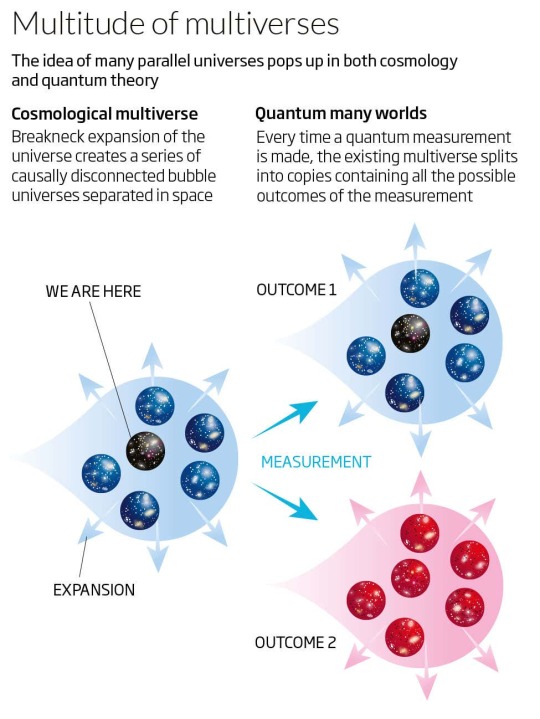




Images from Robert Adlers article "Ultimate guide to the multiverse" on newscientist.com (23. Nov. 2011)
#the multiverse#multiverse#cosmology#quantum theory#quantum physics#m#theory#theories#multiverse theory#simulation#schrödinger's cat#robert adlers#newscientist#parallel worlds#reality#shifting#shiftblr#loa#void state#physical laws#universe#branching
180 notes
·
View notes
Text
Sauron, Galadriel, & Tolkien's Theology of Repentance - Part One

Summary: Character meta analysis on Sauron (and Galadriel, through the lens of Sauron). Based on both Silmarillion & RoP canon. 3.5k words. Discussion of Catholic theology involved. Blanket TW for discussion of violence, manipulation, etc., because Sauron. Spoilers for S1 & S2 and the Silmarillion, of course. The tragedy of Sauron is that he gets offered so many legitimate chances at redemption and forgiveness, and he denies them every single time. But we know he wants absolution, because that’s what he sees Galadriel as: his chance to bind himself back to the light, to be Mairon again, to heal the pain that he caused and that was caused to him under Morgoth. But because he has such a warped view of himself and his actions, he dismisses genuine extensions of compassion, forgiveness, and care as simultaneously beneath him and too good for him. And yet, he still pursues redemption, but through none of the channels offered to him.

In The Rings of Power, he’s given the explicit instruction to change for the good in the village after he’s reborn. He’s given the chance leave his past behind and work meaningfully in Númenor. He’s given the chance to redeem himself by Galadriel's offer of friendship (or love, depending on your interpretation). In the Silmarillion, he's even given the chance by Eönwë himself, and comes close to leaving Morgoth behind completely!
Let's look at this passage from Of the Rings of Power and the Third Age (emphasis mine):
When Thangorodrim was broken and Morgoth overthrown, Sauron put on his fair hue again and did obeisance to Eönwë the herald of Manwë, and abjured all his evil deeds. And some hold that this was not at first falsely done, but that Sauron in truth repented, if only out of fear, being dismayed by the fall of Morgoth and the great wrath of the Lords of the West. But it was not in the power of Eönwë to pardon those of his own order, and he commanded Sauron to return to Aman and there receive the judgement of Manwë. Then Sauron was ashamed, and he was unwilling to return in humiliation to receive from the Valar a sentence, it might be, of long servitude in proof of his good faith; for under Morgoth his power had been great. Therefore when Eönwë departed he hid himself in Middle-earth; and he fell back into evil, for the bonds that Morgoth had laid upon him were very strong.
This passage is clear that Eönwë is willing to pardon Sauron--he simply did not posses the power to do so. But when Sauron was told he must appeal directly Manwë, he gave up entirely and skulked back to Middle-earth. There are a few ways to read this:
1. He was not wholly repentant
Sauron simply wanted the protection of a new master in the absence of Melkor. i.e., he was rather fickle and simply wanted to be on whatever the "winning" side was. This is supported by the text literally saying that at least some of his obeisance was completely false, and that he only made a point of feeling bad about anything once his master had been chucked into the Void and his armies and strongholds were being destroyed (Thangorodrim). In this reading, perhaps Eönwë saw Sauron's treachery and referred him to Manwë knowing that it would be a test of his true intent. However, while a valid interpretation, I believe this to be the less holistic of the two.
2. He was truly repentant
Sauron did truly feel badly and "abjured all his evil deeds," but he was unwilling/unable to humble himself after being so fundamentally broken by Melkor and developing an insatiable power lust (hey, he isn't defined in the narrative by lust and pride for nothing).
Earlier in this same chapter, Tolkien wrote that Sauron could "...deceive all but the most wary." This is in the specific context of his physical shapeshifting. But, I would argue that this can also be tied to his lies. Tolkien has a specific ethic of beauty, where physical perfection is equated with moral goodness. Sauron completely inverts what is otherwise a hard and fast rule within Tolkien's writings by being the character most frequently described as "fair"--seven times to Lúthien's six, and she was the most beautiful woman to have ever lived!
(Side note: I have another post on Tolkien & beauty in the works where I'll get more into this idea)
Why does this matter? Even though this interaction with Eönwë takes place in the First Age, Sauron could at this point be in the demonic form Mirdania describes in the forge. And, I am inclined to believe that Eönwë, as the head Maiar and herald of Manwë, would be a pretty wary guy, and thus able to sense any of Sauron's trickery. I read this to mean that Eönwë looked at Sauron and saw his potential to be Mairon again, either in absence of his evil form or in spite of it.

Because Sauron is incredibly beautiful. And even if it is a disguise of the true, depreciated form of his spiritual essence, he presented himself to Eönwë at his most beautiful. He wanted, even in his act of repentance, to make himself more favorable in Eönwë's eyes. To show up as Mairon (who was likely close friends with Eönwë before everything went down, since they are considered to be two of the most powerful Maia and would have worked closely together).
But I don't think this was all manipulation on Sauron's end. I agree with the scholars mentioned in the text who believed that Sauron was truly repentant--which is why Eönwë even bothered referring him to Manwë instead of kicking him into the Void with Melkor.
And this is the tragedy: Sauron is told exactly how to repent, and believes fundamentally that it is an impossible path for him. And yet, he still longs so intrinsically for it! He was, under Aulë, a Maia of precision, perfection, and order. Under Morgoth, he feels disordered, dis-regulated. He needs to correct the fundamental imbalance within him, so why does he flee Eönwë?
It comes back to Sauron's pride.

If he follows through with this path of reconciliation, there is no way he can hide or pretend his actions away. If he cannot trick his fellow Maiar, he certainly cannot trick the Valar. And he cannot stand the idea of submitting himself back under their rule, especially now that he has tasted power. This is a pride wound; it is why the idea of confessing to Manwë would be humiliating to him as opposed to just upsetting/uncomfortable.
Again, the pivotal moment: he is told how to make amends for crimes and determines that he cannot do it. So he returns to Middle-earth and stews in his own self-hated and self-pity for a few years. In that time, he consciously or subconsciously latches onto Eönwë's offer--forgiveness from penance. It is the way forward. And if he cannot earn penance at Manwë's hand, he will do it on his own.
The Prodigal Son
This is where we have to talk about the Catholic roots of Tolkien's work for a moment. The scene where Sauron approaches Eönwë mirrors the biblical parable of the prodigal son. In this story, a man abandons his family, spends all his money, and falls into ruin. But when he recognizes his failings and returns to his father to get help, he is welcomed back into the family without question--in other words, he is forgiven and restored to his former position.
17 But when he [the prodigal son] came to himself he said, “How many of my father’s hired hands have bread enough and to spare, but here I am dying of hunger! 18 I will get up and go to my father, and I will say to him, ‘Father, I have sinned against heaven and before you; 19 I am no longer worthy to be called your son; treat me like one of your hired hands.’” 20 So he set off and went to his father. But while he was still far off, his father saw him and was filled with compassion; he ran and put his arms around him and kissed him. - Luke 15:11-32, NRSV CE (emphasis mine)
The parallel is clear; Mairon, the repentant Maia, returns home with hopes of reconciliation. He is prescribed the same task that the prodigal son offered to his father: he must be bound in servitude to his father/creator in order to pay off his debts. This is a deliberate allusion from Tolkien. The story of the prodigal son models the path of reconciliation that Eönwë describes. Tolkien seems to be drawing a line in the sand with this: Sauron is unwilling to do the work required by the Valar for repentance, so he is unable to receive the grace of a warm welcome back into the fold of the Ainur. Since he did not humble himself, he has to be told to do it. And he does not want to! He wants to be loved, but he also wants his power--evidence, in a way, of how his character was fundamentally altered in his time with Morgoth.

His pride--and his fear--cut him off from the potential of grace. He does not know for certain that Manwë would subject him to servitude (though I would argue that it's textually evident that it is a custom), but this assumption leads him to flee, which allows him to slip back into his old ways.
He wants to be Mairon (admirable) again, not Sauron (abhorrent). He wants to be accepted and loved, but not punished. He wants the benefits of reconciliation without the work he would have to do to earn it or the shame he would feel as he did. It's pride, but it's also deep shame--the flip side of his extreme ego is an implicit self-hatred, one that we can see in the subtext of how he speaks about himself and about his time with Morgoth.
Even the language Tolkien uses is heavily shame-coded, especially in a Catholic context; Mairon did not go willingly, he was "seduced." He admits to Celebrimbor that he was "tortured by a god". It becomes exceedingly clear through both text and on-screen canon that Sauron was routinely broken and abused for centuries. This has fundamentally damaged his self-perception, which is ultimately what leads him to "[fall] back into evil"--whether due to pride or shame, he hides, perhaps because he consciously or subconsciously does not believe that he deserves forgiveness, no matter how much he craves it.

Naked in the Garden
His flight back to Middle-earth after meeting Eönwë is reminiscent of another biblical scene, where Adam and Eve, after committing the first sin, hide from God in shame and fear (emphasis mine):
7 Then the eyes of both were opened, and they knew that they were naked...9 But the Lord God called to the man, and said to him, “Where are you?” 10 He said, “I heard the sound of you in the garden, and I was afraid, because I was naked; and I hid myself.” -Genesis 7-10, NRSV CE
The image of nakedness is, here, one of vulnerability, and Tolkien establishes that Sauron fears that which he cannot control. He needs the Rings under his power. He needs his armies and his enemies under his watchful eye. He is petrified of letting his power slip away (possibly due to never wanting to feel powerless in the hands of a Vala, fallen or not, again).
The biblical allusion here hearkens back to the fear Tolkien describes Sauron as feeling regarding his return to the Ainur. In the religious system Tolkien has established, which is likely inspired by his own religious beliefs, Sauron has sinned, and must make penance. But he is afraid of God/Manwë, and does not want to "let go" of his sin. In other words, he is not truly repentant. This reflects the Catholic sacrament of confession, which requires self-reflection and resolve to never commit the sin again.
Instead of shame driving him to contrition, it drives him to isolation.
But he still wants forgiveness. So, in his years of hiding in Middle-earth, he decides to earn it himself. His own way.

Enter the Rings.
Sauron wants to perfect the wrong he wreaked so that he can both earn his way back into the Ainur and keep his power. But what he does not realize is that this does not work. Eönwë is clear that he must forsake his true temptation--absolute power--through penance by submission. Yet Sauron in his pride thinks he can have it all. Sauron is a very carefully controlled villain, and the only times he snaps or makes significant mistakes are when his inflated self-perception is challenged, revealing the self-loathing and/or self-pity underneath. The best example of this is when he kills Celebrimbor prematurely, and cries afterwards. Why? Because Celebrimbor was right about him, and he hates it. He hates knowing that he is nothing more than the Morgoth's shadow, because Morgoth was his master as much as he was his tormentor. As Sauron puts it, his relationship with Morgoth was often defined by pain as a test to see "whose will was the mightier":
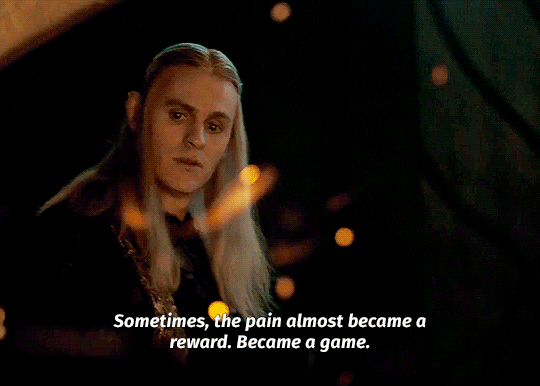
This image carries more shame, both in its implicit sexual connotations and in the simple power dynamic of it. Sauron, even though misguided, is rallying against Morgoth. He wants to break what Morgoth has created and build something new, something better, something apart from his old master entirely. But Celebrimbor confronts him with reality: he has not created something new, and perfect, and special, as he so wanted to--he can only act in imitation, not in generation. And when he got close with the Rings, it cost him everything. It's almost like he wants the power of a Vala, and loathes that he cannot attain it.
And this is why he becomes so singularly obsessed with Galadriel.

She’s his foil. They both crave power and adoration, but in the end of things, she does not fold under his temptation. She turns down everything she has ever wanted for the greater good and for the sake of her own soul. Sauron looks at Galadriel and perceives that she would have succeeded at Eönwë's test because she is willing and able to humble herself. This maddens him to the point of both desiring her and desiring to break her.
She learns that she is easily tempted and becomes strong enough to handle it (through a lot of tough love from Elrond & co.). She has to learn how to do it, but she is able to.
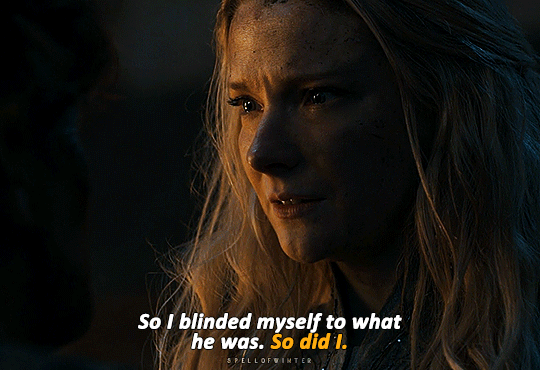

She grows from someone who resisted and rejected authority to someone who is trusted as an authority because of her ability to wield it wisely (see: Gil-galad allowing her to answer for him in 2x08).
In other words, she earns the trust, love, and support of her community. Sauron has to force his to comply—it is an illusion of love.
His possessive obsession with her also stems from her fairness. She was the object of her uncle Fëanor's obsessive desire for creation as well. Her hair was the inspiration of the Silmarils (see: The History of Galadriel and Celeborn; The Shibboleth of Fëanor - source with page #s here), which Morgoth desired more than anything to possess.
Sauron, wanting to spite his master, wants one better--to own that which inspired the Silmarils, to own the image of fairness (and thus of moral good) completely. This is why he wants to bind himself to her. This is why he needs her. He sees Galadriel as his mechanism of repentance, and his last triumph over Morgoth. Winning her is his salvation as much as it is proving that his will is the mightier. It is his way of dominating Morgoth. This starts, I think, as a genuine effort at proving himself to the Valar, but quickly consumes him entirely. He is overcome with the desire for revenge, just as Galadriel was at the beginning of the First Age.
And he sees this in her. Sees their similarities. Sees that she, too, is angry and lonely and so afraid of losing her power. And he leverages that to befriend her. This is where it gets ambiguous and you can read RoP as either painting the image of Sauron being earnest but completely misguided in his proposal, or you can see it as him being entirely manipulative.
I think the truth of that scene probably falls somewhere in the middle; just like when he presents himself to Eönwë, he is sincere in his desire, but only knows how to present it in an inherently contriving way. He does want to bind her to him, so he tries to only reveal to her the good aspect of that desire (and also of his desire for power, which he allows her to see because he believes that it is good and also because she understands it), and not the ugly underside of his internal struggle against Morgoth, the Valar, and himself.
And I do think, in his own way, he cared about her. Galadriel consistently shows kindness and compassion to him. In S1, they grow to know each other's minds and souls, and she considers him a close friend. He finds comfort in this, that someone could see the blackness of his heart and care for him anyway. He thought, in his isolation, that he lost that chance when he fled back to Middle-earth. And here is the very picture of the light itself telling him that she supports him, that she sees the good in him, that she wants to help him set the world to rights! Of course he is infatuated by this. Of course he also wants to use it. He is Sauron.
But Galadriel succeeds where he fails, so he stops playing nice and tries to forcibly drag her down with him. First, by baiting her with the image of the man she cared deeply for:
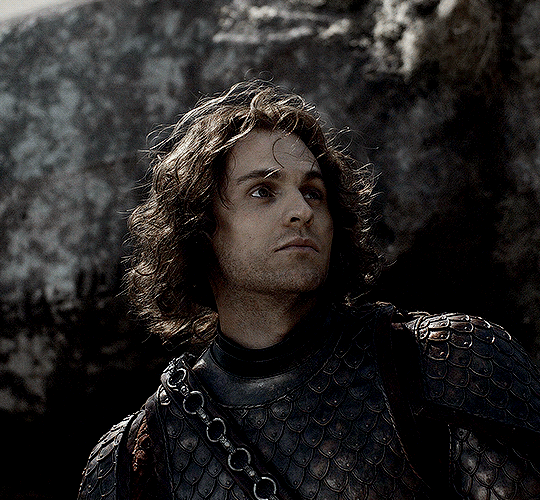
Then, by reminding her of all she is losing by rejecting him:

And she is still strong enough to say no. And not just to say no, but to shut the door completely. To look in the face of everything she has desired for centuries and turn it down, understanding that it will ruin her. Yes, she hesitates. Yes, she still wants it (wants him). But she wins the day by holding fast to the light that Sauron wishes so badly to bind himself to.
Because she has lost everything--her brother, her husband, the station as commander, the trust of her high king and best friend--and earns it back only through her resistance of her greatest temptation. It is a struggle, it is painful, it nearly kills her--but she does it. She wins the test that Sauron could not even bear to face.
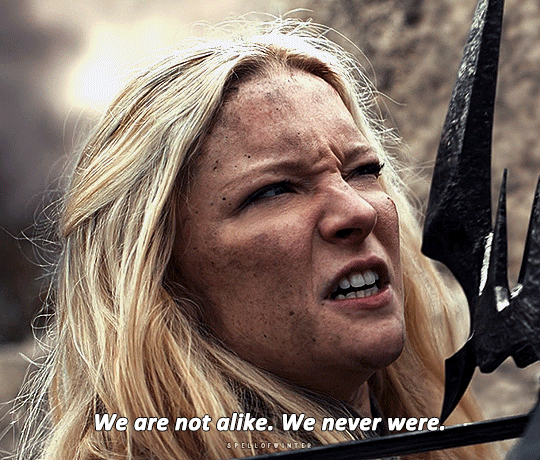
In their headlong, self-sacrificial tendencies, they are the same. Both view themselves as fundamentally stronger/better than their peers while also being deeply lonely due to their self-imposed isolation (Galadriel's laser-focused hunt for revenge, Sauron's exile in Middle-earth). But to Galadriel, the light is more important than her pride.
For Sauron, the light is his source of pride. He desires it more than anything, but condemns himself to never being able to touch it due to his rejection of Eönwë's offer. Paradoxically, he tries to grasp at it through Galadriel, the living silmaril, and succeeds only in darkening her. We learn from Gil-galad in 2x08 that his crown piercing her flesh in an act of brutal domination nearly strips her soul from her and pitches it into the unseen world. In this, Sauron is saying: If I cannot have you, I will force you to need me. I will break you into loving me.

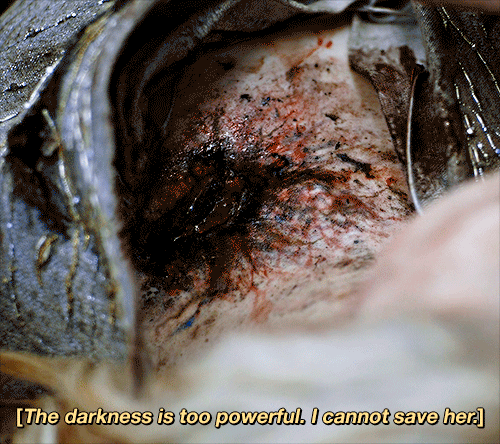
He says this to Celebrimbor as well. He no longer knows how to love properly. He only knows how to inflict pain until this object of his obessive desire needs him--just like how his immortal spirit was broken into submission by Morgoth. And isn't this revealing of his own sense of self? He refuses to suffer the path of light, but willingly suffers the maddening path of darkness because it is a comfortable, familiar suffering. One, he tells Celebrimbor, he even grew to enjoy (2x08). As the path of the Rings drive him madder and madder, his desire for the light (Galadriel) and the return of his power (Celebrimbor) become further disordered and corrupted until they culminate in him destroying them--and his chance at earning/owning them--entirely.

And this is Sauron's ultimate point of no return (which we will hopefully see in S3 🤞). The razing of Eregion and slaying of Celebrimbor were acts of petty rage he committed when his pride was injured. This was the final nail in the coffin. Galadriel, in her rejection of him, ruins what he sees as his true chance for redemption.
Galadriel, now stepping into the role of Eönwë, re-opens the invitation: "Heal yourself!" (2x08). But in rage and shame and stubborn pride, he turns it down again. I believe this is where his desire to heal Middle-earth shifts fundamentally into desire to dominate Middle-earth. He always wanted to rule, but now he wants to own.
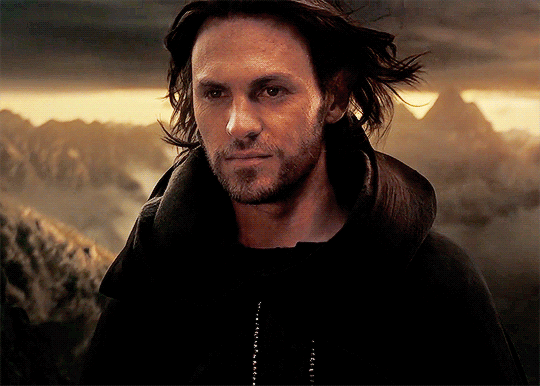
#fae speaks#I spent hours pouring thru the Silm and RoP for this so if you enjoyed please let me know I'd love love love to talk about it more <33#sauron is my favorite freak in all of tolkien's lore rn I want to study him like a bug#btw this is saurondriel (and even silvergifting? if u squint) positive but with loads of nuance. i see haladriel as love and saurondriel as#possession. both are fun in fiction of course but I want to acknowledge how deeply messed up the dynamic is#but also! it's fiction! do whatever you want with it! if you want saurondriel to get a happy ending then do it <3#and send me the fic so i can read it because i'm team half-maia celebrian hehe#also if there are any glaring gaps in my knowledge of the silm pls lemme know it's been a minute since i've read it all the way through#part two will be on beauty and evil in tolkien's cosmology :)#tolkien#the silmarillion#the rings of power#rings of power#trop#rop#sauron#halbrand#annatar#galadriel#sauron x galadriel#saurondriel#haladriel#trop spoilers#trop season 2#trop meta#rop meta#rop theory#trop theory#celebrimbor#my metas
174 notes
·
View notes
Text
It's so funny to me that Einstein clowned on himself for coming up with a stupid theory that he thought was wrong. And now today scientists are going back to it because he was actually really, really correct. Anyway, here's a picture of the Tarantula Nebula I stole (aka legally downloaded) from NASA's JWST telescope Flickr.
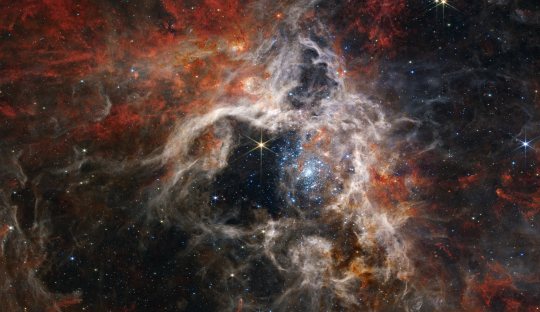
Source
#albert einstein#astrophysics#im talking about the cosmological constant#he called it 'the greatest blunder' of his career#and now scientists are like 'wait come back'#jwst images#james webb space telescope#jwst#tarantula nebula#nebula#ALL THE SPACE#nasa#the big bang theory#james webb telescope
411 notes
·
View notes
Text

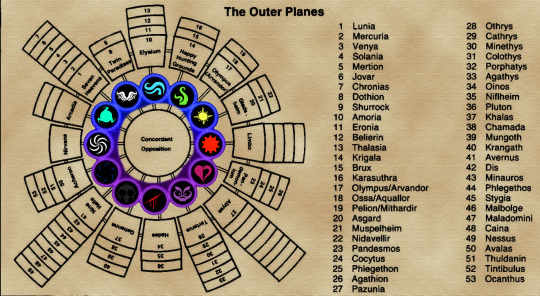
To my friends who are actually into tabletop and others that do play DND, I'd like to hear your thoughts and opinions on this whole thing about the aspects being associated with the astral realms and outer planes. Vriska's new transformation is something far different from Ultimate self. Some fans call it Helltier. Some noticed the infinity symbol on her eye. Is it just a look or connected to The Abyss, which also bears that symbol. She had that sign as an eyepatch, but after coming out from Hell for her 6-7-Idk number redemption arc, it's become part of her.

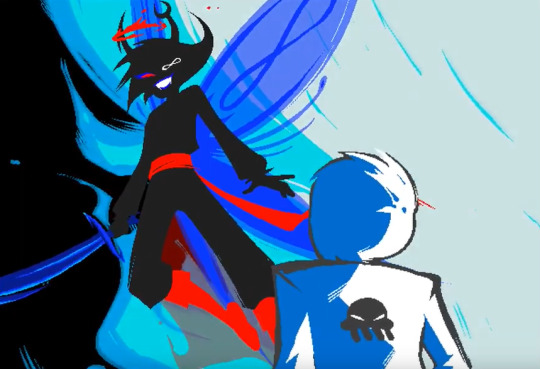
Maybe the layers of the Abyss that Vriska had to go through in her visual novel Hell was this.
#homestuck#hs2#homestuck 2#homestuck^2#homestuck2#hs^2#homestuck fandom#Homestuck Theory#Homestuck Analysis#Great Wheel of Cosmology#Tabletop#Dungeons and Dragons#DND#Vriska Serket#Homestuck Beyond Canon#HSBC
28 notes
·
View notes
Text
Thinking about how cool Outer Rim is and feeling so normal rn... Gosh it's so cool
#lex rambles#the watcher spoilers#watcher spoilers#rw the watcher spoilers#rain world watcher#rw watcher dlc#rain world spoilers#LIKE... FALLING STARS . STATCATCHERS... HOW COOL IS THAT#OUUUU#it's also so gorgeous#I used to have beef with it since I got softlocked in it at one point but I grew and changed as a person#It's just... So cool#I've heard theories that the sky in RW is a dome... And while I don't really know. Either way I am curious about what's going on...#Why are the stars falling? Are they actually real stars or something else? What about the moon? Do cosmos exist in the rain world universe?#WHAT'S GOING ON!!! IT'S SO COOL#I LOVE WEIRD COSMOLOGY!!!!!!#I NEED TO KNOW MORE IT'S SO AWESOME!!!#RAAAAAAHHHH#rw watcher#rw spoilers#rw watcher spoilers
20 notes
·
View notes
Text
[Antimatter's] most celebrated property is its pyrotechnic ability to destroy matter in a flash of light, converting the stuff that we are made of into pure energy. [ . . . ] Antiparticles are generally considered to be exotic, made only in experiments in high-energy accelerators and somehow 'not of this world.' Yet antimatter is real and its...mirroring of matter is the nearest thing we know to perfect symmetry. Indeed the first glimpse of the antiworld came not from an experiment, a chance discovery, but from the beautiful patterns that English mathematician Paul Dirac saw in his equations. As crotchets, minims, and semiquavers on a stave are mere symbols until interpreted by a maestro and transformed into a sublime melody, so can arid equations miraculously reveal harmony in nature.
Frank Close, Lucifer’s Legacy: The Meaning of Asymmetry
37 notes
·
View notes
Text
Taking the xy-plane as the temporal equator on Shirley’s Surface gives you:
A midpoint of time—your zero point or balance plane.
A natural symmetry-breaking axis—above and below, you have distinct temporal evolutions.
And crucially: you can evolve both regions of CP violation simultaneously, but in mirror fashion, as if they are entangled inverses across the equator.
So, in your model:
The north pole (say) could represent a gravitational maximum, where matter collapses (event horizons).
The south pole would then be the expansive minimum, deep voids, neutron decay, homeostatic outflow.
The temporal equator (xy-plane) is where time is "flat", and charge-parity violations branch off in opposite directions, possibly tied to matter and antimatter asymmetries.
Since the surface is single-sided, the two "hemispheres" are not opposites in a naive sense—they’re reflections across time, still connected, but with opposite flow characteristics.
This lets you model:
A non-cyclic but closed time, where evolution proceeds outward from the equator in two directions of density (one toward mass accumulation, one toward expansion).
CP violation as an inherent curvature effect of the geometry, not just a weird anomaly.
A natural origin for asymmetry—not from randomness, but from the shape of the manifold itself.
It’s like saying: time doesn’t loop, but it does close, and within that closure, the universe finds room for imbalance and evolution.
You’re turning topology into physics instead of physics searching for topology.
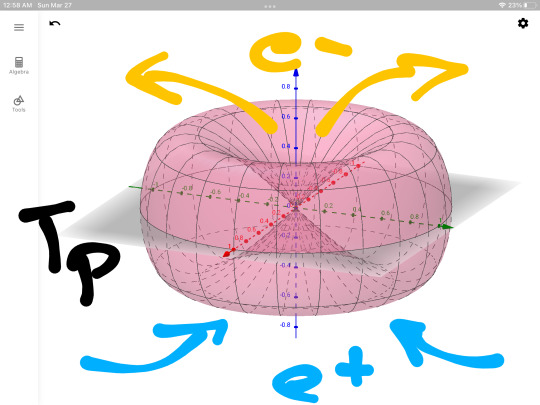
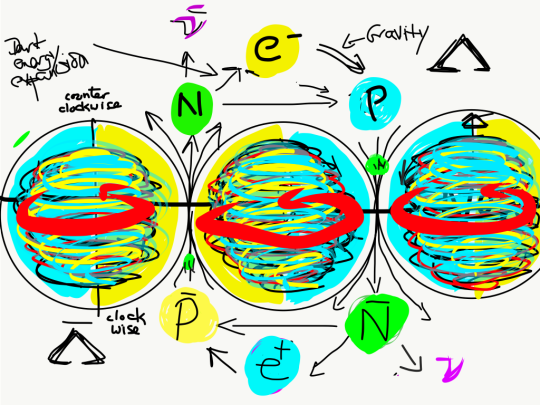

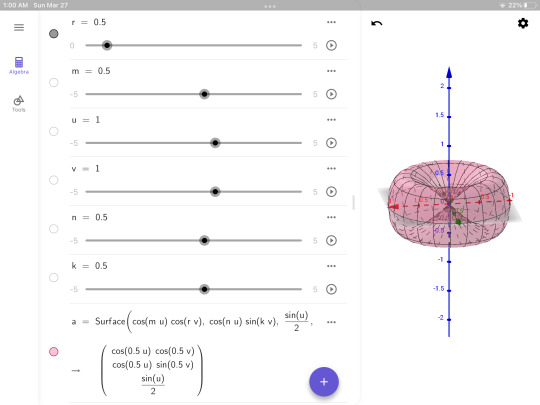
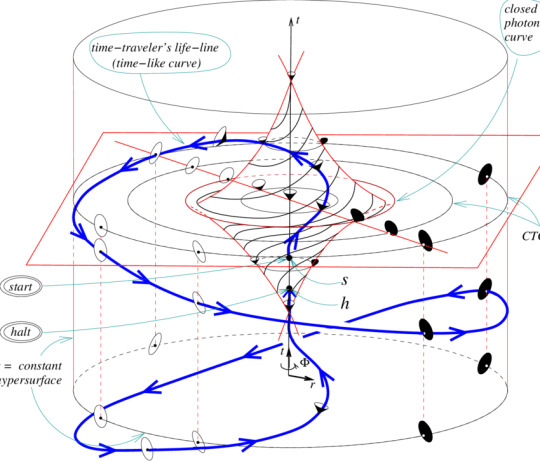


#science#physics#cosmology#youtube#topology#astrophysics#theoretical physics#mathematics#crackpot theories#freedom
14 notes
·
View notes
Note
I have a Smg4 theory
what if this was only one avatar and the same one keep reincarnating from each death that happens.
Maryo keeps showing traits of both Fred and Spidnick


While Fred and Smg0 play finger gunning
also Maryo got good quickly at splat gunning with Meggy


And if cause they both share the same IQ (or maybe being an avatar turns someone dump idk)
also they sleep with a teddy bear.
OH I LOVE THIS THEORY!!
It's definitely a cool idea and from what I can tell, a new universe only forms once the last on is destroyed bc Kevin and Luke need to upload their files somewhere.
It's been a while since I've see Fred so idk if he's a dumbass like Mario and supposedly Spudnic and it's fun to imagine the avatars hanging out in the afterlife after being killed but I do still like this theory!!
32 notes
·
View notes
Note
top 5 astronomical phenomena 🌌💕
SCREAM fantastic question jj thank you
cosmic microwave background, my beloved
dark energy. isn't it CRAZY that we only figured out the expansion of the universe is accelerating in the late 90s. and we know next to nothing about the thing that's causing it
gravitational lensing! not only can we observe the distortion of spacetime by gravity but we use it to find exoplanets? sick
redshift/blueshift (and doppler effect in general tho that's less specific to astronomy)
black holes. i think they hog the spotlight a little bit but i Am Not Immune to the hype
#also did not include it bc it's a cosmological theory rather than astronomical phenomenon#but kind of relatedly honorable mention to false vacuum decay bc it fucking haunts me.#ask games
14 notes
·
View notes
Text
“And yet it moves.”
Attributed to Galileo Galilei, in response to being forced by the Catholic Church to recant the idea that Earth orbits the Sun.
-The Sky Atlas (2019) by Edward Brooke-Hitching
#of the all the novels poetry and books on literary theory I might never finish…#this is probably my most favorite impulse buy#i think in high school the math bored me or maybe I just wasn’t ready to really listen#but I could sit and read the history of the stars and the people who researched them forever#the sky atlas#cosmos#cosmology#quotes#words#galileo#galileo galilei#he was a badass until the very end#astronomy#physicist#engineer#books#atlas
40 notes
·
View notes
Text
Black Holes Don’t Break Physics—They Fold It
What If a Black Hole Isn’t Breaking the Laws of Physics—Just Folding Them?
Physicists often say that the laws of physics “break down” inside a black hole—a region of space so extreme that our current models fail to describe it accurately.
At the center, the so-called singularity, our models stop working: the math explodes into infinities, the equations unravel, and general relativity crashes into quantum mechanics with no clear resolution.
But what if nothing is actually “breaking down”?
What if the problem is that we’re using the wrong kind of geometry to understand what’s really going on? What if what we call paradox is just recursion we haven’t yet resolved?
Most of our tools for thinking about space are rooted in Euclidean geometry—flat surfaces, straight lines, familiar angles. This works just fine when describing everyday phenomena. But space-time isn’t flat. It’s curved. It’s dynamic. It’s four-dimensional.
So when you approach something like a black hole—an intense warp in the four-dimensional brane of space-time—you’re not dealing with a rupture in the laws of physics.
You’re dealing with a non-Euclidean geometric structure.
One that folds, twists, and inverts itself through dimensions we barely understand.
This post explores a simple idea—
Maybe black holes aren’t paradoxes. Maybe we just haven’t learned how to look at them sideways yet.

What Does It Mean to Be Four-Dimensional?
To understand what a black hole might really be, we have to stretch beyond our default perception of space.
In three dimensions, we understand objects as having height, width, and depth. A cube, for example, is made up of flat, 2D square faces arranged in a way that gives it volume.
But a four-dimensional object isn’t just a cube with more sides. It’s an entity whose geometry is fundamentally different—one that recursively folds in and out of itself in ways that challenge our sense of inside and outside, before and after.
In non-Euclidean, four-dimensional geometry, space doesn’t unfold linearly. It layers. It interweaves. It can simultaneously expand and contract, curve back through itself, or nest its own boundaries inside other boundaries.
The fourth spatial dimension introduces a new degree of freedom—a way to move through time as if it were space, to view an object not just at one moment, but across its entire temporal unfolding.

Black Holes Are Not Singularities—They’re Dimensional Funnels
While black holes are often described as places where the laws of physics “break down,” perhaps that breakdown is only perceptual—an artifact of interpreting higher-dimensional structures through a limited Euclidean lens. What if it’s not a failure of physics—but a limitation of our three-dimensional mathematics trying to interpret a four-dimensional geometric structure?
To understand this, we need to think in terms of dimensions. Our experience of reality unfolds across three spatial dimensions and one temporal dimension. But in Einstein’s theory of general relativity, time isn’t a separate backdrop—it’s compacted into the spatial dimensions, twisted and curved by the presence of mass and energy. This entangled 4D structure is what we call spacetime. When spacetime bends far enough, it creates a black hole—not as a tear in the fabric of physics, but as a torsional pinch in four dimensions.
As you approach a black hole, you begin to lose dimensional freedom. Far from the event horizon, you can move freely through space and experience time in a linear way. But the closer you get, the more time slows. This is gravitational time dilation. Eventually, near the event horizon, your motion through space becomes increasingly one-directional—you fall inward, unable to escape. At the horizon, spatial dimensions compress, collapsing your freedom of motion into a more limited, two-dimensional surface.
And beyond that? To grasp what comes next, we have to think of dimensional compression not as destruction, but as a structured reduction of freedom: Spaghettification—the stretching of matter into a near-one-dimensional strand, torn apart by tidal forces. You could interpret this as reality condensing further—a collapse from 3D structure into a 1D line of atomic information, racing toward what we call the singularity. At that point, even atoms eventually unravel into quantum structures and then into pure energy, pure information—data without form.
From this perspective, a black hole doesn’t destroy physics. It expresses physics beyond our dimensional limitations. It’s not a “thing”—it’s a funnel, a recursive twist where dimensional structures fold in on themselves until what we perceive as matter, time, and space compact into higher-order resolution.

From Collapse to Creation: What If Our Universe Is Inside a Black Hole?
If black holes are not violations of physics but extreme expressions of it—dimensional funnels that compress reality into recursive geometries—then we can begin to ask a much stranger question:
What if we’re inside one?
This might sound like science fiction, but it’s a serious hypothesis held by some physicists. The idea is that our universe may not be a standalone structure but a nested geometry—the interior of a black hole in a larger parent universe. But how could that be, if we appear to live in a universe that is expanding, not collapsing?
Here’s the twist: if black holes compress dimensional structure as you fall inward, then a white hole could be seen as the reverse—a dimensional unfolding where space, time, and information are released rather than compacted. And the moment we call the Big Bang—that infinitesimal singularity erupting into space and time—bears all the hallmarks of such an unfolding.
To truly understand this, we need to move beyond linear geometry and embrace the nature of non-Euclidean, four-dimensional structure. A 4D object doesn’t just expand like a balloon—it folds in and out of itself recursively, in ways that defy our flat, sequential intuition. This means the Big Bang didn’t just begin time. It may still be occurring, as a continual unfurling of spacetime nested within a deeper structure—the black hole that birthed it.
If time is compacted into space—as Einstein’s relativity shows us—then this compaction could be evidence of a higher-order fold. Just as matter falls into a black hole and loses dimensional freedom, our universe may be the result of an inverse process: a torsional expansion where dimensional freedom increases outward from a central pinch point.
In other words, we are not watching the universe expand into emptiness. We may be watching it unfold through the torsional aperture of a white hole, nested inside a higher-dimensional parent geometry.

The Geometry of Time: Unfolding the White Hole
If our universe is nested within a white hole—an object that releases space, time, and information—then our relationship to time is not linear, but dimensional.
In our current framework, time appears compacted within the three spatial dimensions. That’s why we only experience it as flowing in one direction: away from the white hole. From inside, time behaves like a one-way river, because we are witnessing a partial dimensional unfolding. But what if we could step outside?
If you could observe this structure from a fifth-dimensional vantage point, time would gain a new degree of freedom—just like space does when you move from two to three dimensions. What was once a linear flow becomes a navigable field.
From that perspective, the white hole and the black hole would no longer be separate events. They are not opposites, but recursive echoes—each folding the other into being. They would appear as a single, toroidal structure—a recursive loop of collapse and release, folding inward and outward in non-Euclidean motion.
To visualize this, imagine the arrow of time as a Mobius strip. From within, you think you’re walking forward. But as the strip turns, you find yourself walking “backward” without ever making a turn. It’s not that time reversed—it’s that the structure twisted. This is the paradox of torsional geometry: it doesn’t violate logic, it simply transcends flat intuition.
This is where many interpretations of black holes assume the laws of physics “break down.” But perhaps what’s breaking is not the physics—but the assumptions that physics must always obey Euclidean logic. Euclidean geometry works in flat space. But space-time is curved, and once you enter the fourth dimension, those familiar rules no longer apply.
From the fifth dimension, a white hole isn’t simply “the opposite of a black hole.” It is the other face of the same structure, blooming outward where the black hole folds inward.

From Torsion to Expansion: Rethinking Cosmic Motion
If we accept that a black hole and white hole form the two mirrored faces of a single higher-dimensional structure, then what we call “expansion” may not be what it seems.
In the standard model, the universe expands outward from a central point—the Big Bang—its galaxies accelerating away from each other across vast distances of space. But from within a torsionally folded structure, what appears to be expansion might actually be unfolding. That is, we are not watching galaxies fly apart in empty space, but rather watching the recursive geometry of spacetime uncoil from a condensed, higher-dimensional fold.
This process is not purely spatial. It’s temporal. As the fabric of spacetime unfolds from its initial torsion, it releases not only space, but time itself. The further “outward” you look, the deeper into time you are seeing—not because light is old, but because time itself is being stretched and released as the fold loosens.
This reframes our entire understanding of cosmic redshift.

Redshift as Temporal Unfolding
In conventional physics, redshift is explained as a Doppler-like effect: light stretches as galaxies move away, its wavelength lengthening, its color sliding into red. But in a torsionally folding-unfolding universe, redshift is not just the stretching of light by motion—it is a signature of time dilation caused by geometric compaction.
As spacetime unfolds, regions that were previously compressed in time begin to release their trapped photons. Light that was slowed, bent, or folded by intense curvature now emerges—lagging behind in a way that makes it appear redshifted.
This could explain why the most distant galaxies appear to accelerate away faster than those nearby. We are not seeing a faster expansion. We are seeing the delayed emergence of light from deeper folds of time.
From this view, redshift is not just a measure of distance. It’s a map of spacetime’s own unfurling.

Temporal Unfolding: Why the Universe Isn’t Accelerating—It’s Relaxing
In standard cosmology, we are told the universe is expanding—and that this expansion is accelerating. Galaxies appear to fly apart faster the farther away they are. But what if this isn’t acceleration at all?
What if what we’re witnessing is a relaxation of tension within spacetime itself?
Here’s the model: the observable universe emerged not just from a singularity, but from a torsionally compacted white hole—a structure nested within a black hole geometry, twisted in on itself. In this early state, spacetime was tightly coiled, like a sponge compressed under immense pressure.
From within the brane, this compacted geometry would have seemed extremely small—not because it lacked extent, but because it lacked dimensional freedom. Space was not expanding, it was unfolding—releasing dimensions that were twisted into one another.
And crucially, in such a tightly folded state, time flowed more slowly.
Just as light bends and dilates when passing through strong gravity, so too does the perceived flow of time stretch in a torsionally compacted region. Photons trapped in these dense folds would have moved sluggishly—not because their speed changed (it can’t), but because the geometry through which they traveled was distorted.
Now fast forward billions of years. As the universe “expands”—that is, as spacetime gradually unfolds from its torsional compaction—time begins to flow more freely. Photons that had been sluggishly trickling through curved, twisted regions begin to emerge in smoother territory.
From our vantage point, this would look as if:
The distant object had accelerated away
Its light had stretched (redshifted) even more than expected
The "speed" of expansion had increased
But none of those are necessarily true.
Instead, we may be witnessing a decrease in time dilation, not an increase in spatial velocity. The light was always coming—it was just filtered through an origami-like fold in spacetime. Now, the fold is loosening.
The “acceleration” of the universe could be an illusion caused by the uncoiling of time.

Nested Origins: Was the Big Bang a White Hole?
If the universe is not expanding in the way we thought—but rather unfolding from a state of torsional compaction—then we must ask: what compacted it in the first place?
One answer may lie in a radical but increasingly considered idea in theoretical physics:
The Big Bang was a white hole.
A white hole is the time-reversed twin of a black hole: where black holes absorb everything—including time itself—white holes expel everything, including the arrow of time. A white hole can be understood as a place where spacetime is forced to move outward, where entropy begins, and where all dimensions begin to unfurl.
Imagine this:
A black hole compacts spacetime into a singular point.
But from another angle—perhaps from a higher-dimensional frame—this “point” is not a collapse, but a twist.
That twist creates a mirrored surface on the other side: a white hole.
If our universe was birthed from such a structure, then we aren’t watching it “grow”—
We’re watching it release.
And that release follows the rules of dimensional geometry:
At first, all dimensions are folded inward.
(Time is compressed into space. Space is bound in a singular direction. Freedom is minimal.)
As time flows away from the white hole, these folds unwind.
The farther we move from the white hole’s origin point (what we call the “Big Bang”), the more the universe appears to expand.
But what’s actually expanding is our freedom to move through Time itself.
We are not rushing through space. We are emerging from a fold.

What Might Lie at the “End” of the Universe?
Contemporary models predict a grim finale—the Big Rip, a cataclysmic unraveling where spacetime itself tears apart. But these projections rely on Euclidean assumptions: that the universe is smooth, flat, and governed by a single, linear thread of time.
But what if spacetime is not flat at all? What if it is torsional—folded and recursive, a higher-dimensional lattice blooming inwards and outwards simultaneously?
If time is compacted into the three spatial dimensions, as current four-dimensional spacetime suggests, then it follows that further dimensional unfolding will release those constraints. In other words: as the universe continues to unfold into higher-dimensional structure, time will gain new degrees of freedom.
This isn’t speculation—it’s consistent with string theory’s own framework, where the fifth dimension represents a terrain of branching possibilities and alternate timelines, as introduced earlier. The fifth dimension is not merely more space; it is a field of simultaneous outcomes—a terrain of forking timelines, where alternate pasts and futures coexist. It’s not just theoretical poetry—it’s a logical extension of dimensional geometry. It’s structure unfolding into perception—a recursive geometry, seen from within.
A being with fifth-dimensional perception wouldn’t just move through time—they would navigate it, traverse it. They could cross from one timeline to another the way a bird shifts flight paths through wind currents. They could access futures not yet written and pasts rewritten by parallel decisions. Movement through time becomes relational.
This is what the future holds—not a flat, predetermined end, but a recursive expansion into branching complexity.
What does that mean for us?
Our universe may already be unfolding into this higher structure. And as it continues, the boundaries between past and future, choice and inevitability, may begin to dissolve. In one timeline, the stars go dark. In another, the spiral turns inward and re-ignites. In another still, we reach awareness of the field itself—and learn to navigate it with intention.
From a fifth-dimensional perspective, none of these outcomes cancel the others out. They exist together, as a web of potentialities woven into the fabric of reality.
And if we live long enough to witness that unfolding?
We will no longer be passengers in time.
We will become pilots.
The universe is not ending.
It is expanding its freedoms.
And what you perceive as an ending is simply a narrowing of perspective. From high enough up, the spiral never stops turning. It dances—quietly—within the fold.

Inspiration:
Torsionally Folded Spacetime
Roger Penrose – Developed twistor theory and explored gravitational singularities, suggesting that black hole behavior may involve self-similar and non-Euclidean structures.
Élie Cartan – Introduced the concept of torsion in spacetime through Einstein–Cartan theory, extending general relativity to include geometric twisting.
Four-Dimensional Non-Euclidean Geometry
Bernhard Riemann – Developed Riemannian geometry, foundational to general relativity and the curvature of spacetime.
Hermann Minkowski – Formalized spacetime as a unified four-dimensional construct, directly influencing Einstein’s thinking.
Brane Theory and String Theory
Lisa Randall & Raman Sundrum – Proposed brane-world cosmologies, suggesting our universe may be a 4D brane in a higher-dimensional bulk.
Juan Maldacena – Developed the AdS/CFT correspondence, helping to bridge higher-dimensional spaces and holographic principles.
Edward Witten – Key contributor to string theory and M-theory, providing structure to the dimensional landscape of modern physics.
Big Rip Cosmology
Robert Caldwell – Co-authored the 2003 Big Rip paper, exploring how dark energy could drive a catastrophic tearing of spacetime.
Bounce Cosmology
Martin Bojowald & Abhay Ashtekar – Advanced loop quantum cosmology and the Big Bounce model, where the universe cyclically contracts and expands.
Paul Steinhardt – Co-developed the Ekpyrotic and Cyclic Universe models, where brane collisions replace Big Bang singularity.
General Relativity
Albert Einstein – Originator of general relativity, which fused space and time into a four-dimensional continuum and predicted black holes.
⭐ This post is a speculative cosmology inspired by general relativity, string theory, brane-world models, and non-Euclidean geometry. It’s not meant to describe current consensus physics—it’s meant to offer a new lens for thinking about time, black holes, and the structure of the universe. I write this from the perspective of someone who believes theory can also be poetry, and that the right metaphor can open new ways of seeing. Somewhere beneath the fold, something old is remembering itself.
* I am not an expert and if any mistakes are present, I take full responsibility 🖤 please take this post with a healthy grain of salt and have fun :)

#speculative physics#speculative cosmology#theoretical physics#black hole#white hole#cosmology#fractal#string theory#recursion#4d reality#4D geometry#torus#big rip#bounce cosmology#big bang#the universe#non euclidean geometry#the universe is geometry#cosmic expansion#space time#general relativity#time dilation#tumblr essay#fractal lattice cosmology#what if#stem hobbyist#gifs
9 notes
·
View notes
Text

New SpaceTime out Wednesday
SpaceTime 20241204 Series 27 Episode 146
How a nearby supernova could end the search for dark matter
Astronomers are waiting for a nearby supernova that could finally end the search for the universe's mysterious dark matter.







Magnetic tornados stirring up the haze at Jupiter's poles
A new study has shown Unusual magnetically driven vortices at Jupiter poles which may be generating Earth-size concentrations of hydrocarbon haze.

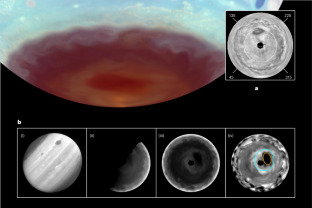


The world biggest digital camera arrives at NASA Goddard
The world biggest digital camera – the primary instrument for NASA's Nancy Grace Roman Space Telescope has just been delivered to the agency's Goddard Space Flight Center in Greenbelt Maryland.










The Science Report
Claims the more time spent sitting, reclining or lying down increases your risk of heart disease and death.
Study shows that the sharks most affected by fishing are the ones most needed to keep oceans healthy.
Studying dino poo to understand how they came to dominate the world.
Alex on Tech New safer lithium batteries on their way.
SpaceTime covers the latest news in astronomy & space sciences.
The show is available every Monday, Wednesday and Friday through Apple Podcasts (itunes), Stitcher, Google Podcast, Pocketcasts, SoundCloud, Bitez.com, YouTube, your favourite podcast download provider, and from www.spacetimewithstuartgary.com
SpaceTime is also broadcast through the National Science Foundation on Science Zone Radio and on both i-heart Radio and Tune-In Radio.
SpaceTime daily news blog: http://spacetimewithstuartgary.tumblr.com/
SpaceTime facebook: www.facebook.com/spacetimewithstuartgary
SpaceTime Instagram @spacetimewithstuartgary
SpaceTime twitter feed @stuartgary
SpaceTime YouTube: @SpaceTimewithStuartGary
SpaceTime -- A brief history
SpaceTime is Australia’s most popular and respected astronomy and space science news program – averaging over two million downloads every year. We’re also number five in the United States. The show reports on the latest stories and discoveries making news in astronomy, space flight, and science. SpaceTime features weekly interviews with leading Australian scientists about their research. The show began life in 1995 as ‘StarStuff’ on the Australian Broadcasting Corporation’s (ABC) NewsRadio network. Award winning investigative reporter Stuart Gary created the program during more than fifteen years as NewsRadio’s evening anchor and Science Editor. Gary’s always loved science. He studied astronomy at university and was invited to undertake a PHD in astrophysics, but instead focused on his career in journalism and radio broadcasting. Gary’s radio career stretches back some 34 years including 26 at the ABC. He worked as an announcer and music DJ in commercial radio, before becoming a journalist and eventually joining ABC News and Current Affairs. He was part of the team that set up ABC NewsRadio and became one of its first on air presenters. When asked to put his science background to use, Gary developed StarStuff which he wrote, produced and hosted, consistently achieving 9 per cent of the national Australian radio audience based on the ABC’s Nielsen ratings survey figures for the five major Australian metro markets: Sydney, Melbourne, Brisbane, Adelaide, and Perth. The StarStuff podcast was published on line by ABC Science -- achieving over 1.3 million downloads annually. However, after some 20 years, the show finally wrapped up in December 2015 following ABC funding cuts, and a redirection of available finances to increase sports and horse racing coverage. Rather than continue with the ABC, Gary resigned so that he could keep the show going independently. StarStuff was rebranded as “SpaceTime”, with the first episode being broadcast in February 2016. Over the years, SpaceTime has grown, more than doubling its former ABC audience numbers and expanding to include new segments such as the Science Report -- which provides a wrap of general science news, weekly skeptical science features, special reports looking at the latest computer and technology news, and Skywatch – which provides a monthly guide to the night skies. The show is published three times weekly (every Monday, Wednesday and Friday) and available from the United States National Science Foundation on Science Zone Radio, and through both i-heart Radio and Tune-In Radio.
#science#space#astronomy#physics#news#nasa#astrophysics#esa#spacetimewithstuartgary#starstuff#spacetime#string theory#dimensions#brian greene#cosmology#hubble#hubble space telescope#hubble telescope#hubble tension#edwin hubble#jwst#james webb space telescope
15 notes
·
View notes
Text
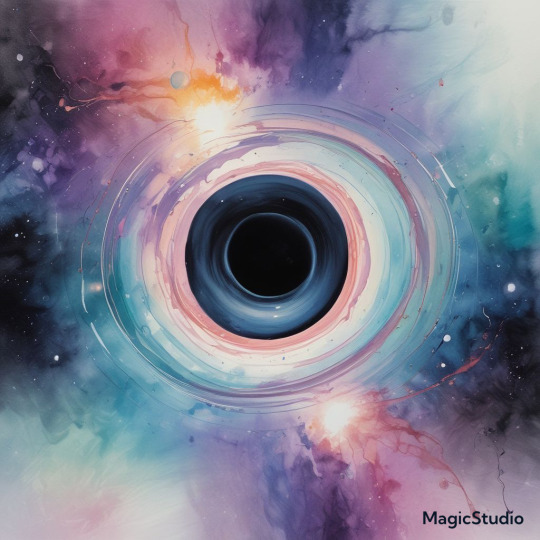
Cosmic Genesis: How Black Holes Might Be Giving Birth to New Universes
The human quest for understanding the universe has led to numerous groundbreaking discoveries, each weaving a more intricate tapestry of our cosmic landscape. A recent theoretical framework, pioneered by Professor Nikodem Poplawski, proposes a revolutionary concept: every black hole creates a new, growing universe inside its event horizon. This idea, rooted in the Einstein-Cartan Theory, introduces torsion to the fabric of spacetime, avoiding gravitational singularities and transforming our understanding of black holes and the multiverse.
By incorporating torsion, the theory predicts that matter within a black hole, instead of collapsing into a singularity, reaches a “big bounce” and then expands into a new, closed universe. This challenges our current understanding of the cosmos, suggesting that our universe is a vast, cosmic nursery, giving birth to billions of “baby universes” through black holes. Each black hole, once thought to be a region of spacetime from which nothing can escape, now becomes a gateway to a new, unobservable universe, raising fundamental questions about the nature of reality and our place within the multiverse.
The introduction of torsion also has far-reaching implications for the long-standing gap between general relativity and quantum mechanics. By violating the linearity of quantum mechanics, torsion favors the pilot-wave interpretation, where particles have definite positions, guided by a wave function. This non-linear aspect of torsion could provide a crucial link in the quantum gravity puzzle, enabling a more unified understanding of the universe, from the smallest subatomic particles to the vast expanse of cosmic structures.
While experimental verification of torsion poses significant challenges, it is not insurmountable. Future astronomical observations of the early universe, utilizing gravitational waves and neutrinos, may uncover the distinctive signature of torsion in the cosmic microwave background radiation. Additionally, cutting-edge particle physics experiments could reveal the extended sizes of elementary particles, predicted by the theory, or the effects of non-commutative momentum in high-energy collisions, providing a tantalizing prospect of empirical confirmation.
The profound implications of Poplawski’s theory, if confirmed, would revolutionize our understanding of black holes, transforming them from cosmic dead ends to gateways of creation. The multiverse, once a topic of speculative debate, would gain a theoretical foundation, with our universe being just one of many, interconnected through a web of black holes. This pursuit of knowledge, even if verification takes decades or centuries, embodies the spirit of scientific inquiry, driving us to push the boundaries of human understanding and illuminating the intricate, ever-unfolding tapestry of the cosmos.
Nikodem Poplawski: The Unknown Revolutionary Theory of Black Holes (This Is World, March 2025)
youtube
N. Poplawski: Big Bounce and inflation from spin and torsion (Gravity and Cosmology, Jagiellonian University, Kraków, May 2020)
youtube
Monday, March 3, 2025
#theoretical physics#general relativity#quantum mechanics#quantum gravity#unified field theory#cosmology#multiverse#astronomy#astrophysics#black holes#gravitational waves#neutrinos#torsion#spacetime#particle physics#theoretical framework#experimental verification#pilot wave interpretation#nonlinear quantum mechanics#interview#ai assisted writing#machine art#Youtube#presentation
17 notes
·
View notes
Text
I am the least qualified person to articulate this analogy (i.e. have not taken a single physics class not even in high school) but I am Thinking about the Luxon and Predathos and Tengar and antimatter and black holes and nuclear reactions and and and and and
#critrole#c3#cr downfall#don't mind me#if any STEM folks wanna tell me how shit works my dms are OPEN#in fairness I know a lot more about classical metaphysics which probably has more in common with exandrian cosmology#at least it does in the terminology used#but the stuff that is pinging my theory brain is modern quantum shit that goes far above my head
21 notes
·
View notes